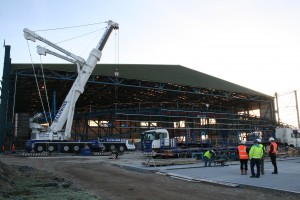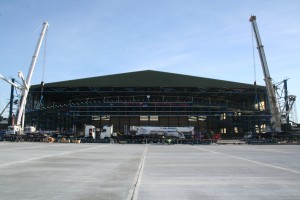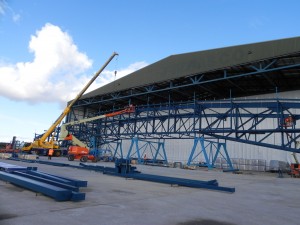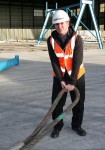Working with Civils Contracting Limited, this extension to the existing Hangar 12 at Bournemouth Airport has a clear span of 100m, is 12m deep and 22m high to the eaves. The Main Contractor’s work started on this project in the summer of 2013 and we commenced assembly of the main truss at the beginning of October 2013.
Being a very unusual and local job, it was decided to install a timelapse camera in order to record progress, managed between bouts of the windiest weather experienced since 1987.
This camera takes a photo every 10 seconds and these can then be played back in sequence and roll like a film. The effect is that we can see the action of many days taking place at a super quick pace. Within the space of a couple of minutes, the whole front arch of the hangar appears before your eyes.
 With 80% of our work destined for overseas markets it is unusual to have such a project on our doorstep and all REIDsteel staff from the office and works were given the opportunity to visit when the truss had been pre-assembled at ground level, in preparation of the big lift. The chance to get up close and personal with a steel structure doesn’t come along often and gave the staff a taste of what our site teams can achieve with the materials designed, drawn and manufactured at our Christchurch facility.
With 80% of our work destined for overseas markets it is unusual to have such a project on our doorstep and all REIDsteel staff from the office and works were given the opportunity to visit when the truss had been pre-assembled at ground level, in preparation of the big lift. The chance to get up close and personal with a steel structure doesn’t come along often and gave the staff a taste of what our site teams can achieve with the materials designed, drawn and manufactured at our Christchurch facility.
Once the pre-assembly work had been carried out, it was then time for the 140T truss to be lifted into position, using a 500T and a 1000T crane. Due to the ever-changing weather, the procedure, originally being delayed by two weeks, was then brought forward 24 hours to take advantage of a perfectly still day. With the help of our suppliers, Civils and Bournemouth International Airport, we were given the green light to go ahead with the lift, which was witnessed by the Designer, Richard Callaghan and Draughtsman, Steve Roberts.
Richard Callaghan was on site the day the main lift occurred. He said of his visit to site:
 “All personnel were on site early and ready to lift the frame as soon as the light permitted. The complex nature of a lift of this magnitude merited the earliest start possible due to the hire cost of the large cranes which were required for the 140 tonne load.
“All personnel were on site early and ready to lift the frame as soon as the light permitted. The complex nature of a lift of this magnitude merited the earliest start possible due to the hire cost of the large cranes which were required for the 140 tonne load.
On the ground, the custom made lifting equipment looked unusually large; but once it was attached to the frame, it looked much smaller. Nevertheless, it was too late for second guessing; the calculations had been checked and re-checked, and, in theory, all was in order.
When the frame was lifted off the trestles and the lifting gear looked solid, I could relax a little. As time went on, and the truss was slowly lifted into place, it was only connecting the frame to the columns which remained a concern. As expected, bolting the frame into place proved a long and laborious process. However, thanks to the hard work and level heads of our team of erectors, the connections were completed.
Once the cranes had started their dismantling process, our team of erectors could enjoy a well-earned breakfast sometime in the middle of the afternoon.
All in all, the day proved to be a success. The lift started promptly, the weather remained calm, the truss was lifted into place safely, the difficult connections were overcome, the client’s representative appeared to be happy and I had a very tasty lunch in the flying club café. However, my overriding memory of the day is that I wish I had worn two pairs of socks!”







